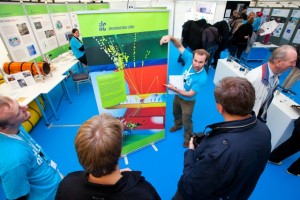It’s hard to imagine that not too long ago the mention of particle physics would make people shrug and walk away. Last Saturday, the German lab DESY opened its doors to the public, and busloads of people – families, neighbours, groups of friends – flooded the campus. They tried their hands at manoeuvring overhead cranes, admired the precision machines in the workshops and waited patiently for hours outside the entrance to the HERA tunnel, site of DESY’s former particle accelerator, to walk one length of it and emerge in a former detector hall. Many of the more than 13 000 visitors also found their way into the ‘particle tent’, specially erected for DESY’s contribution to LHC, ILC and astroparticle physics.
DESY’s ILC group proudly presented their work, the science arguments for the ILC, a model of a time projection chamber and even a mini PET scanner with real detectors. A do-it-yourself linear accelerator with cranks instead of cavities and with balls instead of particles was popular with the kids, and there was even a dedicated ILC talk by Karsten Buesser. ILC software expert Steve Aplin, one of the many DESY staff who volunteered as an ‘info source’, particularly remembers one discussion with two students of archaeology who started out knowing nothing about high-energy physics. “I explained to them that particle event reconstruction was not really that different from reconstructing a Ming vase,” says Aplin. “When you start, you don’t really know it’s a Ming vase, just a bunch of pieces, some of which are easy to recognise, others not. The missing pieces are like our neutrinos, and the bits of building material and stones are our background.” In the end, you either have a restored vase or a better idea of what happened at the particle collision.
Hamburg’s science institutions get together for a city-wide “Science Night” every two years. This year’s event attracted 20 000 visitors in total. DESY of course features heavily on the programme, and in order to cope with the stream of visitors it usually adds a day to the night, with gates opening at noon and closing again 12 hours later. The DESY campus is an extremely busy place with lots of construction sites and new research programmes, so many people come to every Open Day to learn about what’s new. This year, the organisers came up with a new concept of proposing themed walks to different places on site. One walk concentrated on accelerators, one on everything to do with X-rays, and one, of course, on particle physics. There was also a special tour for children and one about the ‘pillars of science’, highlighting the workshops, heavy lifting, computer centre and other services that science couldn’t be without. These tours helped people find their way around campus, and if somebody did get lost, there were enough DESY volunteers in blue T-shirts around to put them back on track.
Visitors might not have understood the Higgs mechanism in one day, but they certainly have a better picture of life at a major research lab. Aplin concludes, “Those archaeology students certainly seemed pleased to have understood a bit more clearly what we do.”



Recent Comments